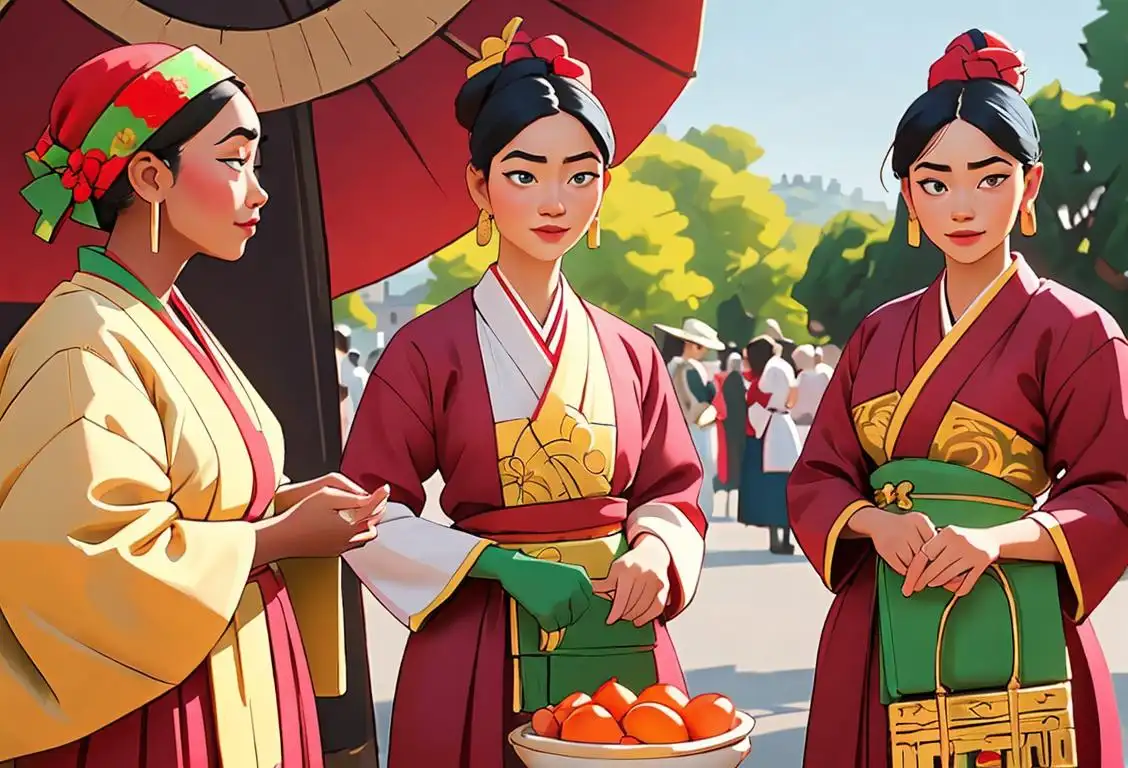National Traditional Clothes Day

Hey there, fashionistas! Get ready to strut your stuff on National Traditional Clothes Day! Whether you're rocking a kilt, a kimono, or a dirndl, this day is all about celebrating the diverse and vibrant world of traditional clothing. So, slip into something fabulous and let's dive into the history and excitement of this fashionable holiday!
When is Traditional Clothes Day?
It's national traditional clothes day on the 10th March.
A Glimpse into Fashion History
National Traditional Clothes Day is a day dedicated to honoring the cultural heritage and unique fashion traditions that have been passed down through generations. From the stunning sarees of India to the elegant hanboks of Korea, traditional clothing carries stories and symbolism that connect us to our past.
Throughout history, clothing has played a vital role in expressing cultural identity and values. It reflects the artistic sensibilities, climate, geographic conditions, and even the social status of a particular community or region. Traditional garments not only speak volumes about style but also serve as a visual representation of a country's heritage and traditions.
A Modern Twist on Tradition
While traditional clothing is deeply rooted in history, it continues to evolve and adapt to the modern world. Many designers and fashion enthusiasts are incorporating traditional elements into contemporary fashion, creating a fusion of tradition and innovation. This trend not only promotes cultural awareness but also celebrates the rich tapestry of global fashion.
On National Traditional Clothes Day, people embrace their roots by donning traditional attire. Whether it's sharing a photo online, participating in a cultural event, or simply appreciating the beauty of traditional garments, this day offers an opportunity to celebrate diversity and foster cross-cultural understanding.
Did You Know?
In Japan, there is a tradition of wearing kimonos during special occasions, such as weddings or festivals. But did you know that there are over 200 different styles of kimonos? Talk about endless fashion possibilities!
History behind the term 'Traditional Clothes'
Ancient Times
The Birth of Traditional Clothing
Traditional clothing has roots that go back thousands of years. In ancient times, before the advent of modern manufacturing techniques, people made their clothes using natural materials such as animal skins, plant fibers, and woven fabrics. Each culture had its unique style of dress, which often reflected their social status, religious beliefs, and environmental conditions. These early garments were designed to provide protection from the elements while allowing freedom of movement.
Middle Ages (5th - 15th century)
The Flourishing of Traditional Clothing
During the Middle Ages, traditional clothing became more refined and elaborate. The rise of feudalism and the hierarchical social structure led to the development of specific dress codes for different classes of people. Nobles and royalty wore luxurious and extravagant garments made from expensive fabrics such as silk, velvet, and brocade, adorned with intricate embroidery and jewels. Peasants, on the other hand, wore simpler and more practical clothing made from coarse fabrics like wool and linen.
Renaissance (14th - 17th century)
The Renaissance Influence
The Renaissance period marked a significant shift in traditional clothing. Inspired by the revival of classical art and culture, fashion became a means of self-expression and personal style. It was during this time that tailoring techniques improved, resulting in more fitted and flattering garments. Traditional clothing reflected the ideals of the Renaissance, with intricate details, voluminous sleeves, and elaborate accessories. The upper-class men wore doublets, breeches, and ruffled collars, while women embraced corsets, farthingales, and ornate headpieces.
Industrial Revolution (18th - 19th century)
The Rise of Mass-Produced Clothing
With the advent of the Industrial Revolution, traditional clothing underwent a significant transformation. The invention of textile machinery and factories enabled the mass production of clothes, making them more affordable and accessible to the general population. As a result, traditional clothing styles became more standardized and less diverse. The emergence of fashion trends also contributed to the creation of a globalized clothing culture.
20th Century
Revival of Traditional Clothing
In the 20th century, there was a renewed interest in traditional clothing as a way of celebrating cultural heritage and preserving identity. Movements such as the Arts and Crafts movement and the folk revival encouraged the revival of traditional craftsmanship and indigenous textile techniques. Traditional clothing began to be seen as a symbol of cultural pride and a way to differentiate oneself from mainstream fashion. This resurgence led to the incorporation of traditional elements into contemporary fashion and the popularity of traditional clothing as a form of self-expression.
Present Day
Traditional Clothing in a Globalized World
Today, traditional clothing continues to evolve and adapt to the changing times. It remains an important part of cultural identity and a way to connect with one's heritage. Traditional clothing is often showcased during special occasions, festivals, and national holidays, further highlighting its significance. With the rise of social media and global travel, traditional clothing has also gained international recognition, influencing fashion trends and fostering cross-cultural exchange. Regardless of the era, traditional clothing serves as a tangible link to the past and a testament to the rich diversity of human culture.
Did you know?
In Japan, there are over 200 different styles of kimonos!Tagged
romance awareness funFirst identified
9th March 2016Most mentioned on
10th March 2016Total mentions
58Other days
Suicide Prevention Month Day
Iloveyou Day
Happiness Day
Do Something Nice Day
Compliment Day
Single Ppl Day
Dance Day
Honesty Day
Kiss A Ginger Day
Kissing Fried Chicken Day









